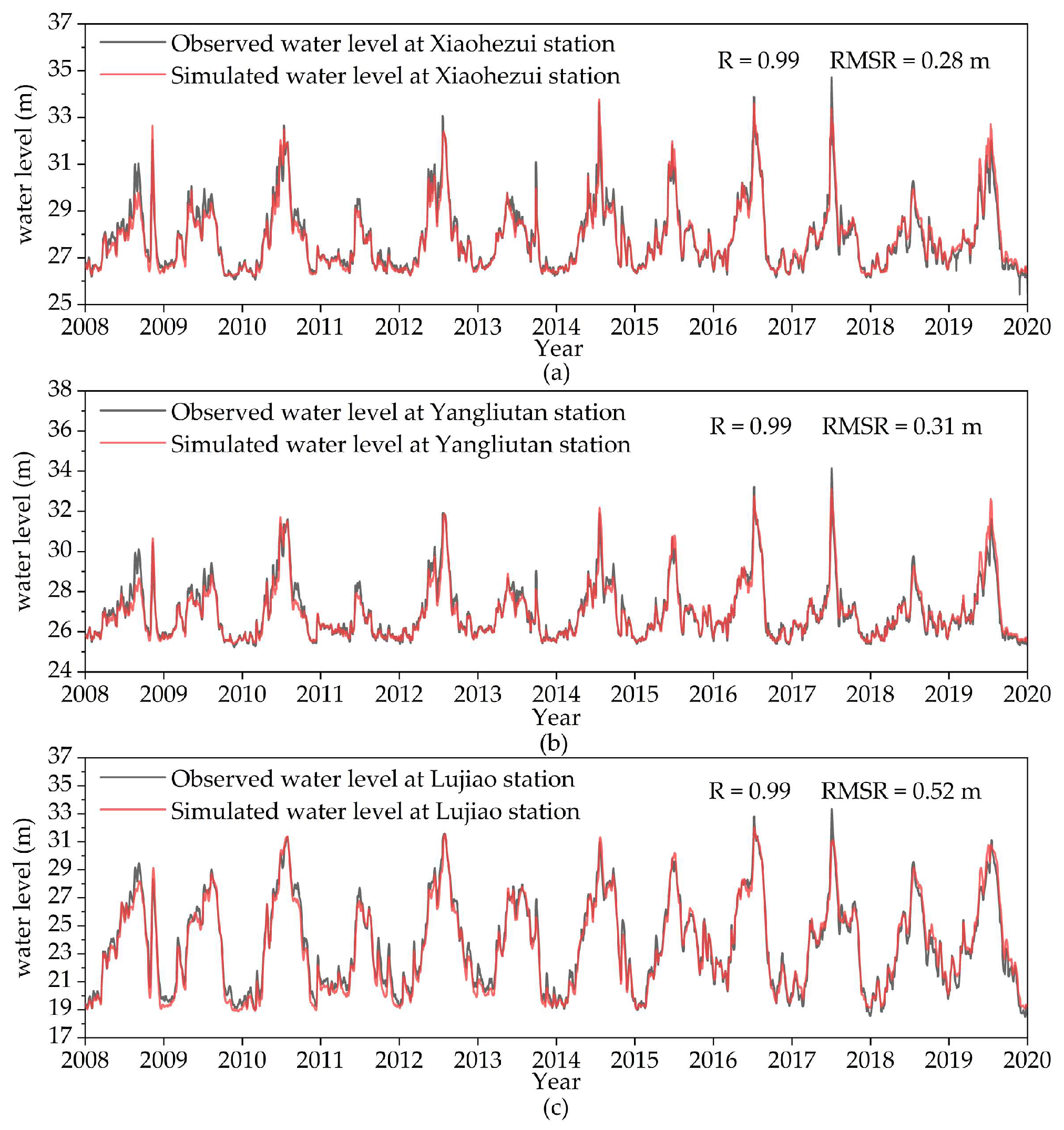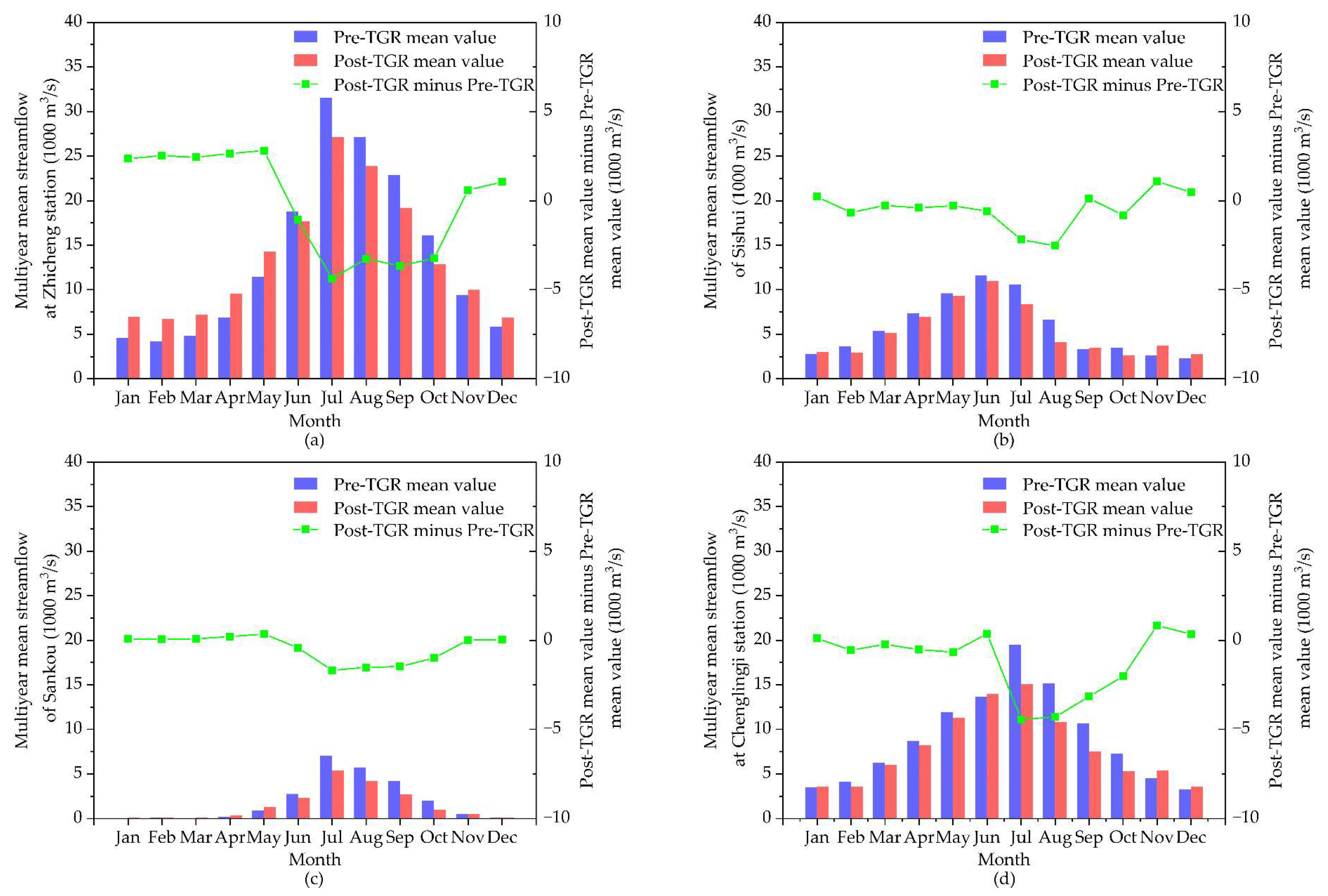Differentiating the Effects of Streamflow and Topographic Changes on the Water Level of Dongting Lake, China, Using the LSTM Network and Scenario Analysis
Abstract
:1. Introduction
2. Study Area and Data
2.1. Study Area
2.2. Hydrological Data
3. Methods
3.1. Detection of Abrupt Change in Water Level Using Heuristic Segmentation Algorithm
3.2. Long Short-Term Memory Neural Network Techniques
3.3. Water Level Simulation Using LSTMNN
3.4. Scenario Analysis to Calculate the Contribution of Changes in Streamflow and Topographic Conditions
- The pre-TGR period streamflows of Zhicheng station, Xiangtan station, Taojiang station, Taoyuan station, and Shimen station were input into the pre-TGR model, resulting in the simulated water levels () of WDL, SDL, and EDL.
- The pre-TGR period streamflow of Zhicheng station and the post-TGR period streamflows of Xiangtan station, Taojiang station, Taoyuan station, and Shimen station were input into the pre-TGR model, resulting in the simulated water levels () of WDL, SDL, and EDL.
- The post-TGR period streamflows of Zhicheng station, Xiangtan station, Taojiang station, Taoyuan station, and Shimen station were input into the pre-TGR model, resulting in the simulated water levels () of WDL, SDL, and EDL.
- The post-TGR period streamflows of Zhicheng station, Xiangtan station, Taojiang station, Taoyuan station, and Shimen station were input into the post-TGR model, resulting in the simulated water levels () of WDL, SDL, and EDL.
4. Results
4.1. Detection of Abrupt Change in Water Level in Dongting Lake
4.2. Training, Testing, and Verification of LSTMNN
4.3. Hydrological Changes in the Dongting Lake Basin
4.4. Contribution of Changes in Streamflow and Topographic Conditions
5. Discussion
5.1. Topographic Changes in Dongting Lake
5.2. Limitations and Future Research
6. Conclusions
Author Contributions
Funding
Data Availability Statement
Conflicts of Interest
References
- Wang, S.R.; Meng, W.; Jin, X.C.; Zheng, B.H.; Zhang, L.; Xi, H.Y. Ecological security problems of the major key lakes in China. Environ. Earth Sci. 2015, 74, 3825–3837. [Google Scholar] [CrossRef]
- Yang, Y.; Liu, W.; Zhang, J.; Yang, L.; Jia, M.; Zhu, L. Changes of Divergence and Confluence Relationship Between Dongting Lake and the Yangtze River After the Operation of the Three Gorges Project and Its Impact on the Waterway Depth. Front. Earth Sci. 2022, 10, 829669. [Google Scholar] [CrossRef]
- Sun, Z.D.; Huang, Q.; Opp, C.; Hennig, T.; Marold, U. Impacts and Implications of Major Changes Caused by the Three Gorges Dam in the Middle Reaches of the Yangtze River, China. Water Resour. Manag. 2012, 26, 3367–3378. [Google Scholar] [CrossRef]
- Liu, Y.Z.; Yang, S.Q.; Jiang, C.B.; Long, Y.N.; Deng, B.; Yan, S.X. Hydrological Drought in Dongting Lake Area (China) after the Running of Three Gorges Dam and a Possible Solution. Water 2020, 12, 2713. [Google Scholar] [CrossRef]
- Wan, R.; Wang, P.; Dai, X.; He, Z. Water safety assessment and spatio-temporal changes in Dongting Lake, China on the basis of water regime during 1980–2014. J. Water Clim. Change 2020, 11, 877–890. [Google Scholar] [CrossRef]
- Guan, L.; Lei, J.L.; Zuo, A.J.; Zhang, H.; Lei, G.C.; Wen, L. Optimizing the timing of water level recession for conservation of wintering geese in Dongting Lake, China. Ecol. Eng. 2016, 88, 90–98. [Google Scholar] [CrossRef]
- Zhang, P.; Zou, Y.; Xie, Y.; Zhang, H.; Liu, X.; Gao, D.; Yi, F. Shifts in distribution of herbivorous geese relative to hydrological variation in East Dongting Lake wetland, China. Sci. Total Environ. 2018, 636, 30–38. [Google Scholar] [CrossRef]
- Fang, J.; Li, Y.; Wang, D.; Xie, S. Modified Hydrological Regime on Irrigation and Water Supply in Lake Areas: A Case Study of the Yangtze River–Dongting Lake. Front. Earth Sci. 2022, 10, 888729. [Google Scholar] [CrossRef]
- Pan, B.; Wang, H.; Li, Z.; Ban, X.; Liang, X.; Wang, H. Macroinvertebrate assemblages in relation to environments in the dongting lake, with implications for ecological management of river-connected lakes affected by dam construction. Environ. Prog. Sustain. Energy 2017, 36, 914–920. [Google Scholar] [CrossRef]
- Gao, Y.; Xie, Y.H.; Zou, D.S. Hydrological regime change and its ecological responses in East Dongting Lake, China. Ecohydrol. Hydrobiol. 2020, 20, 142–150. [Google Scholar] [CrossRef]
- Dai, L.Q.; Mao, J.Q.; Wang, Y.; Dai, H.C.; Zhang, P.P.; Guo, J.L. Optimal operation of the Three Gorges Reservoir subject to the ecological water level of Dongting Lake. Environ. Earth Sci. 2016, 75, 1111. [Google Scholar] [CrossRef]
- Hu, W.; Li, G.; Li, Z. Spatial and temporal evolution characteristics of the water conservation function and its driving factors in regional lake wetlands—Two types of homogeneous lakes as examples. Ecol. Indic. 2021, 130, 108069. [Google Scholar] [CrossRef]
- Bhatti, U.A.; Marjan, S.; Wahid, A.; Syam, M.; Huang, M.; Tang, H.; Hasnain, A. The effects of socioeconomic factors on particulate matter concentration in China’s: New evidence from spatial econometric model. J. Clean. Prod. 2023, 417, 137969. [Google Scholar] [CrossRef]
- Zheng, S.; Cheng, H.; Tang, M.; Xu, W.; Liu, E.; Gao, S.; Best, J.; Jiang, Y.; Zhou, Q. Sand mining impact on Poyang Lake: A case study based on high-resolution bathymetry and sub-bottom data. J. Oceanol. Limnol. 2022, 40, 1404–1416. [Google Scholar] [CrossRef]
- Huang, F.; Chunyu, X.Z.; Wang, Y.K.; Zhang, X.; Qian, B.; Zhao, D.Y.; Xia, Z.Q. Impacts of Streamflow and Topographic Changes on Water Level during the Dry Season of Poyang Lake, China. J. Hydrol. Eng. 2020, 25, 05020001. [Google Scholar] [CrossRef]
- Zhang, J.; Xu, K.; Yang, Y.; Qi, L.; Hayashi, S.; Watanabe, M. Measuring water storage fluctuations in Lake Dongting, China, by Topex/Poseidon satellite altimetry. Environ. Monit. Assess. 2006, 115, 23–37. [Google Scholar] [CrossRef] [PubMed]
- Yan, Y.; Du, Y.; Xiao, F.; Zheng, Y.H.; Zhu, L.L.; Chen, J.C.; Xu, J.W. Remote sensing of seasonal variations in the beaches of Dongting Lake. Phys. Geogr. 2017, 38, 1–17. [Google Scholar] [CrossRef]
- Dai, X.; Yang, G.; Wan, R.; Li, Y. The effect of the Changjiang River on water regimes of its tributary Lake East Dongting. J. Geogr. Sci. 2018, 28, 1072–1084. [Google Scholar] [CrossRef]
- Bernaola-Galván, P.; Ivanov, P.C.; Amaral, L.A.N.; Stanley, H.E. Scale invariance in the nonstationarity of human heart rate. Phys. Rev. Lett. 2001, 87, 168105. [Google Scholar] [CrossRef]
- Huang, F.; Xia, Z.; Li, F.; Wu, T. Assessing sediment regime alteration of the upper Yangtze River. Environ. Earth Sci. 2013, 70, 2349–2357. [Google Scholar] [CrossRef]
- Huang, S.Z.; Huang, Q.; Leng, G.Y.; Zhao, M.L.; Meng, E.H. Variations in annual water-energy balance and their correlations with vegetation and soil moisture dynamics: A case study in the Wei River Basin, China. J. Hydrol. 2017, 546, 515–525. [Google Scholar] [CrossRef]
- Shoaib, M.; Shamseldin, A.Y.; Melville, B.W. Comparative study of different wavelet based neural network models for rainfall–runoff modeling. J. Hydrol. 2014, 515, 47–58. [Google Scholar] [CrossRef]
- Hochreiter, S.; Schmidhuber, J. Long short-term memory. Neural Comput. 1997, 9, 1735–1780. [Google Scholar] [CrossRef] [PubMed]
- Zhou, F.; Huang, Z.; Zhang, C. Carbon price forecasting based on CEEMDAN and LSTM. Appl. Energy 2022, 311, 118601. [Google Scholar] [CrossRef]
- Wang, S.; Takyi-Aninakwa, P.; Jin, S.; Yu, C.; Fernandez, C.; Stroe, D.-I. An improved feedforward-long short-term memory modeling method for the whole-life-cycle state of charge prediction of lithium-ion batteries considering current-voltage-temperature variation. Energy 2022, 254, 124224. [Google Scholar] [CrossRef]
- Bhatti, U.A.; Huang, M.; Neira-Molina, H.; Marjan, S.; Baryalai, M.; Tang, H.; Wu, G.; Bazai, S.U. MFFCG–Multi feature fusion for hyperspectral image classification using graph attention network. Expert Syst. Appl. 2023, 229, 120496. [Google Scholar] [CrossRef]
- Huang, Q.; Sun, Z.D.; Opp, C.; Lotz, T.; Jiang, J.H.; Lai, X.J. Hydrological Drought at Dongting Lake: Its Detection, Characterization, and Challenges Associated With Three Gorges Dam in Central Yangtze, China. Water Resour. Manag. 2014, 28, 5377–5388. [Google Scholar] [CrossRef]
- Yang, Y.; Zhang, M.; Zhu, L.; Zhang, H.; Liu, W.; Wang, J. Impact of the operation of a large-scale reservoir on downstream river channel geomorphic adjustments: A case study of the Three Gorges. River Res. Appl. 2018, 34, 1315–1327. [Google Scholar] [CrossRef]
- Lai, X.H.; Chen, H.W.; Hou, Y.B.; Finlayson, B.; Li, M.T.; Chen, J. Lowering water level of Dongting Lake of the Mid-Yangtze River in response to large-scale dam construction: A 60-year analysis. Geomorphology 2021, 391, 107894. [Google Scholar] [CrossRef]
- Wu, G.; de Leeuw, J.; Skidmore, A.K.; Prins, H.H.; Liu, Y. Concurrent monitoring of vessels and water turbidity enhances the strength of evidence in remotely sensed dredging impact assessment. Water Res. 2007, 41, 3271–3280. [Google Scholar] [CrossRef] [PubMed]
- Lai, X.; Shankman, D.; Huber, C.; Yesou, H.; Huang, Q.; Jiang, J. Sand mining and increasing Poyang Lake’s discharge ability: A reassessment of causes for lake decline in China. J. Hydrol. 2014, 519, 1698–1706. [Google Scholar] [CrossRef]
- Zheng, Z.B.; Li, Y.M.; Guo, Y.L.; Xu, Y.F.; Liu, G.; Du, C.G. Landsat-Based Long-Term Monitoring of Total Suspended Matter Concentration Pattern Change in the Wet Season for Dongting Lake, China. Remote Sens. 2015, 7, 13975–13999. [Google Scholar] [CrossRef]
- Meng, X.; Jiang, X.; Li, Z.; Wang, J.; Cooper, K.M.; Xie, Z. Responses of macroinvertebrates and local environment to short-term commercial sand dredging practices in a flood-plain lake. Sci. Total Environ. 2018, 631, 1350–1359. [Google Scholar] [CrossRef] [PubMed]
- Wang, H.; Huang, L.; Guo, W.; Zhu, Y.; Yang, H.; Jiao, X.; Zhou, H. Evaluation of ecohydrological regime and its driving forces in the Dongting Lake, China. J. Hydrol. Reg. Stud. 2022, 41, 101067. [Google Scholar] [CrossRef]











| Hydrological Station | Location | Period | Data Type |
|---|---|---|---|
| Xiaohezui | West Dongting Lake | 1992–2019 | Water level |
| Yangliutan | South Dongting Lake | 1992–2019 | Water level |
| Lujiao | East Dongting Lake | 1992–2019 | Water level |
| Chenglingji | East Dongting Lake | 1992–2019 | Streamflow |
| Xiangtan | Xiangjiang River | 1992–2019 | Streamflow |
| Taojiang | Zishui River | 1992–2019 | Streamflow |
| Taoyuan | Yuanjiang River | 1992–2019 | Streamflow |
| Shimen | Lishu River | 1992–2019 | Streamflow |
| Xinjiangkou | Songzikou | 1992–2019 | Streamflow |
| Shadaoguan | Songzikou | 1992–2019 | Streamflow |
| Mituosi | Taipingkou | 1992–2019 | Streamflow |
| Kangjiagang | Ouchikou | 1992–2019 | Streamflow |
| Guanjiapu | Ouchikou | 1992–2019 | Streamflow |
| Zhicheng | Yangtze River | 1992–2019 | Streamflow |
Disclaimer/Publisher’s Note: The statements, opinions and data contained in all publications are solely those of the individual author(s) and contributor(s) and not of MDPI and/or the editor(s). MDPI and/or the editor(s) disclaim responsibility for any injury to people or property resulting from any ideas, methods, instructions or products referred to in the content. |
© 2023 by the authors. Licensee MDPI, Basel, Switzerland. This article is an open access article distributed under the terms and conditions of the Creative Commons Attribution (CC BY) license (https://creativecommons.org/licenses/by/4.0/).
Share and Cite
Zou, J.; Huang, F.; Yu, F.; Shen, X.; Han, S.; Qian, Z.; Jiang, H. Differentiating the Effects of Streamflow and Topographic Changes on the Water Level of Dongting Lake, China, Using the LSTM Network and Scenario Analysis. Water 2023, 15, 3742. https://doi.org/10.3390/w15213742
Zou J, Huang F, Yu F, Shen X, Han S, Qian Z, Jiang H. Differentiating the Effects of Streamflow and Topographic Changes on the Water Level of Dongting Lake, China, Using the LSTM Network and Scenario Analysis. Water. 2023; 15(21):3742. https://doi.org/10.3390/w15213742
Chicago/Turabian StyleZou, Jihu, Feng Huang, Feier Yu, Xingzhi Shen, Shuai Han, Zhan Qian, and Heng Jiang. 2023. "Differentiating the Effects of Streamflow and Topographic Changes on the Water Level of Dongting Lake, China, Using the LSTM Network and Scenario Analysis" Water 15, no. 21: 3742. https://doi.org/10.3390/w15213742
APA StyleZou, J., Huang, F., Yu, F., Shen, X., Han, S., Qian, Z., & Jiang, H. (2023). Differentiating the Effects of Streamflow and Topographic Changes on the Water Level of Dongting Lake, China, Using the LSTM Network and Scenario Analysis. Water, 15(21), 3742. https://doi.org/10.3390/w15213742







